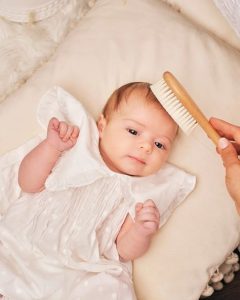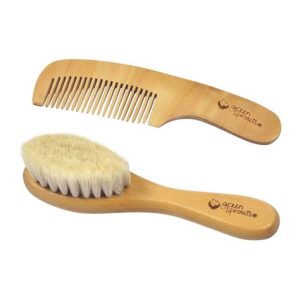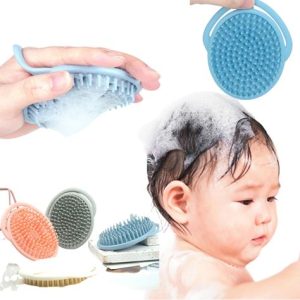Brushing and combing your baby’s hair is an important part of their grooming routine. A gentle baby comb can help distribute natural oils, remove cradle cap, and keep your baby’s hair healthy and tangle-free. Here’s a guide to everything you need to know about baby combs.
Benefits of Using a Baby Comb
Distributes natural oils:
Regular combing helps spread your baby’s natural scalp oils throughout their hair, keeping it soft and moisturized.
Reduces cradle cap:
Cradle cap is a common condition in newborns that causes crusty, flaky patches on the scalp. Gentle combing can help loosen and remove these flakes.
Keeps hair tangle-free:
As your baby’s hair grows, it can become tangled. A comb can help gently detangle hair without pulling or causing discomfort.
Stimulates the scalp:
Brushing and combing your baby’s hair in a gentle circular motion can help stimulate blood circulation in the scalp, which may promote hair growth.
Promotes bonding:
Taking the time to comb your baby’s hair can be a calming and bonding experience for both you and your little one.

Choosing the Right Baby Comb
When choosing a baby comb, look for the following features:
-
Soft bristles: Baby combs should have soft, rounded bristles that won’t scratch your baby’s delicate scalp. Natural bristles, such as those made from goat hair, are often a good choice.
-
Wide teeth: Wide teeth are gentler on your baby’s hair and scalp than narrow teeth.
-
Comfortable handle: A comfortable handle will make combing your baby’s hair easier and more enjoyable for you.
-
Safety: Look for a comb made from safe, BPA-free materials.
How to Comb Your Baby’s Hair
-
Timing is key: The best time to comb your baby’s hair is usually after a bath when their hair is soft and easier to manage.
-
Be gentle: Always use gentle strokes when combing your baby’s hair. Start at the ends and work your way up to the roots to avoid pulling or tangles.
-
Brush cradle cap flakes: If your baby has cradle cap, you can use a soft brush to loosen the flakes before gently combing them out.
-
Watch for tears: If your baby starts to fuss or cry, stop combing and try again later. Some babies simply don’t enjoy having their hair combed.
-
Cleaning the comb: Wash your baby’s comb regularly with warm soapy water and dry it completely before using it again.
Additional Tips for Baby Hair Care
Not every day:
You don’t need to comb your baby’s hair every day. A few times a week is usually sufficient.
Keep it short (optional):
Keeping your baby’s hair short can help reduce tangles and make combing easier. But this is entirely a personal preference!
Skip the harsh chemicals:
Avoid using adult hair products on your baby’s hair. These products can be too harsh for their delicate scalp.
Embrace the natural look:
There’s no need to style your baby’s hair with products or accessories. Their natural hair is beautiful!
By following these tips, you can keep your baby’s hair healthy and tangle-free with the help of a gentle baby comb.

Fun with Baby Combs!
Once you’ve chosen a safe and gentle baby comb, there are some fun ways to incorporate combing into your baby’s routine:
-
Sing a song: Singing a soothing song while you comb your baby’s hair can make the experience more enjoyable for both of you.
-
Make it a game: Turn combing into a game by gently “brushing” the hair of their favorite stuffed animal first. Then, you can say something silly like “brushing the birdie out of baby’s hair” as you comb their hair.
-
Story time: Comb your baby’s hair while reading them a story. This can be a calming and relaxing way to end the day.
-
Bonding time: Taking a few minutes each day to comb your baby’s hair can be a special bonding experience. It’s a time to focus on your baby and show them love and care.

A baby comb is a simple yet essential tool for keeping your baby’s hair healthy and tangle-free. By choosing the right comb and using gentle combing techniques, you can ensure your baby’s delicate scalp is comfortable while keeping their hair looking its best. Remember, the most important thing is to be gentle and patient with your baby. Combing their hair should be a positive experience for both of you.
Beyond the Basics: Fun Facts and History of Baby Combs
Combs have been around for thousands of years, and they’ve played an important role in baby care for centuries! Here are some fun facts and historical tidbits about baby combs:
-
Ancient combs: Some of the earliest combs date back to ancient civilizations like Egypt and Greece. These combs were often made from wood, bone, or ivory.
-
Multiple materials: Throughout history, baby combs have been made from a variety of materials, including wood, metal, tortoise shell, and even precious gems!
-
Symbol of love: In some cultures, combs were seen as symbols of love and care. Giving a baby comb as a gift was a way to show affection and well-being.
-
Modern advancements: Today, baby combs are typically made from safe and gentle materials like plastic or soft bristles. This ensures comfort and safety for your baby’s delicate scalp.
A baby comb is a simple tool with a long history. By using a gentle comb and following these tips, you can keep your baby’s hair healthy and manageable while creating positive bonding experiences.
Travel Tips for Baby Combs
Traveling with a baby can be an adventure, but it can also disrupt routines. Here are some tips for keeping your baby comb handy and clean while traveling:
-
Choose a portable comb: Look for a baby comb that is small and lightweight, easy to pack in a diaper bag or purse.
-
Protect the bristles: Consider a comb with a protective case to keep the bristles clean and prevent them from bending.
-
Cleaning on the go: Pack a small container with a cap filled with clean water for rinsing the comb after each use. Baby wipes can also be a handy option for quick cleaning.
-
Let it dry completely: Before packing the comb away, make sure it air dries completely to prevent any moisture build-up.
A baby comb is a useful tool for keeping your baby’s hair healthy and tangle-free. By following these tips, you can ensure your baby’s comb stays clean and usable, no matter where your travels take you.



Leave a Reply